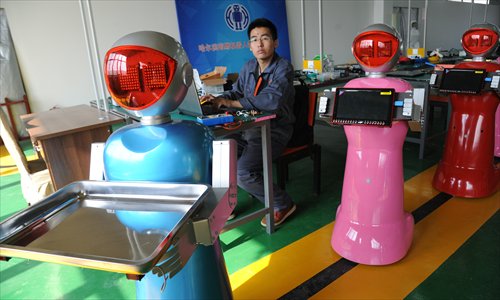HOME >> BUSINESS
Old industrial base Northeast China seeks new life as the country’s supply-structure reform pursues quality growth
By Xinhua - Global Times Source:Xinhua-Global Times Published: 2019/11/18 19:53:40

A technician sits in an office with robots designed for ordering, cooking and delivering dishes on display at a robot production base in Harbin, capital of Northeast China's Heilongjiang Province on Tuesday. Jia Dechang (not pictured), a political advisor and a professor at Harbin Institute of Technology, suggested during the just-concluded two sessions that China develop the city into a nation-level intelligent robot industry demonstration base, as it is in line with the country's efforts to rejuvenate old industrial bases in Northeast China, the Xinhua News Agency reported. Photo: CFP
A 5 yuan banknote featuring a steelworker carrying a poker in front of a furnace has evoked feelings of nostalgia in many Chinese people at a popular exhibition in the Shenyang Finance Museum.
"This 5 yuan note issued in the 1960s is particularly noteworthy. It has won worldwide acclaim for its design and colors," said Liu Lei, deputy director of the museum's research office.
One out of five people worldwide use the Chinese yuan. As a leading symbol of the China, the images on these banknotes depict the economic and social development of new China over the last seven decades, Liu said.
How did the image of a steelworker come to appear on the note? The answer can be found in Angang Steel Co, or Ansteel, "the cradle of China's steel industry."
Ansteel began operations just 12 weeks before the People's Republic of China was founded on October 1, 1949. After decades of warfare and chaos, China's annual steel output was only 158,000 tons at the time, accounting for 0.1 percent of the world's total.
The country began to invest heavily in the steel sector due to its essential role in industrial development.
In the city of Anshan in Northeast China's Liaoning Province, where Ansteel is located, nearly every household is connected to the steel industry.
Following in the footsteps of his father and grandfather, Wang Dong became a steelworker in 2004 after he retired from the army.
"I often went to my father's workplace when I was a child. It was very dusty. He had to stand on a wooden board which insulated the heat from the floor," said the 43-year-old Wang.
Now the workplace has been automated, and living and working conditions of steelworkers have been improved. Wang describes himself as a doctor for the machines. Thanks to his job, he was able to marry and buy an apartment and car.
"Workers of my father's generation are hard-working and willing to make sacrifices. The new steelworkers should embrace innovation and keep learning new technologies," he said.
Now, Ansteel is able to produce around 39 million tons of steel a year. The company's advanced steel can be found in many key projects such as the Qinghai-Tibet Railway, the Bird's Nest, the country's first aircraft carrier - the Liaoning - and the Hong Kong-Zhuhai-Macao Bridge.
On the back of its booming heavy industry, Northeast China, which includes Liaoning, Jilin and Heilongjiang provinces, was among the first regions in China to become industrialized.
Over time, however, it gradually fell behind coastal areas of the country in part due to shrinking resources and industrial, structural problems like overcapacity.
As China deepens its supply-side structural reform in pursuit of quality growth, its old industrial base is trying to foster new growth engines.
In Siasun, a "robot kingdom" around 100 kilometers from Ansteel, people are focusing on the senior care sector, serving the future of humanity.
Li Xuewei, general manager of Siasun's medical and health robot division, joined the company in 2001. Three years ago, he led a team developing medical and senior care robots which hit the market last year.
"Chinese society is aging. As Chinese people grow wealthier, they are demanding a better quality of life and better health services. Here, intelligent equipment can help," Li said.
Among the company's products, adjustable electric beds are the most popular. Users can control the beds with their mobile phones, tablets, voice or eye movements, assisting them to sit up and roll over.
Having experienced both glory and decline, China's northeastern region has been going all out to transform itself and attract not only domestic firms like Siasun, but also international investors.
German automaker BMW Group established a joint venture in Shenyang in 2003, which has grown to be its largest production base worldwide.
BMW has invested around 56 billion yuan ($7.98 billion) in its Shenyang facilities since 2009. Last year, it announced its plan to invest over 3 billion euros ($3.32 billion) in new and existing plants in the city.
Daniel Schaefer, Technology and Manufacturing Senior Vice President of BMW Brilliance, said that more than a fifth of all BMW cars worldwide were produced in Shenyang in 2018.
From 2020, BMW's fully electric iX3 models will be produced exclusively in Shenyang and exported to the world. "It showcases our new development chapter: in China for China and for the world," he said.
Posted in: ECONOMY